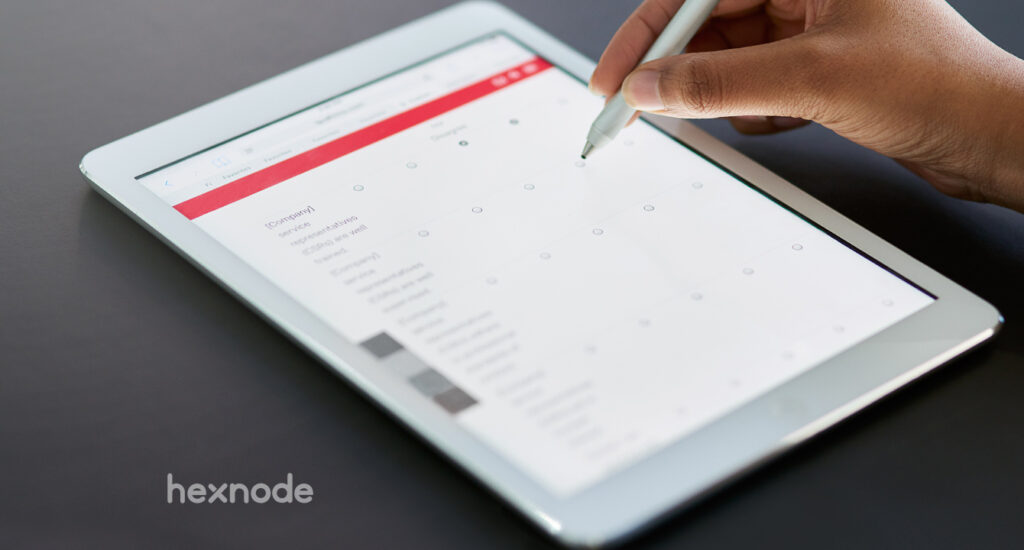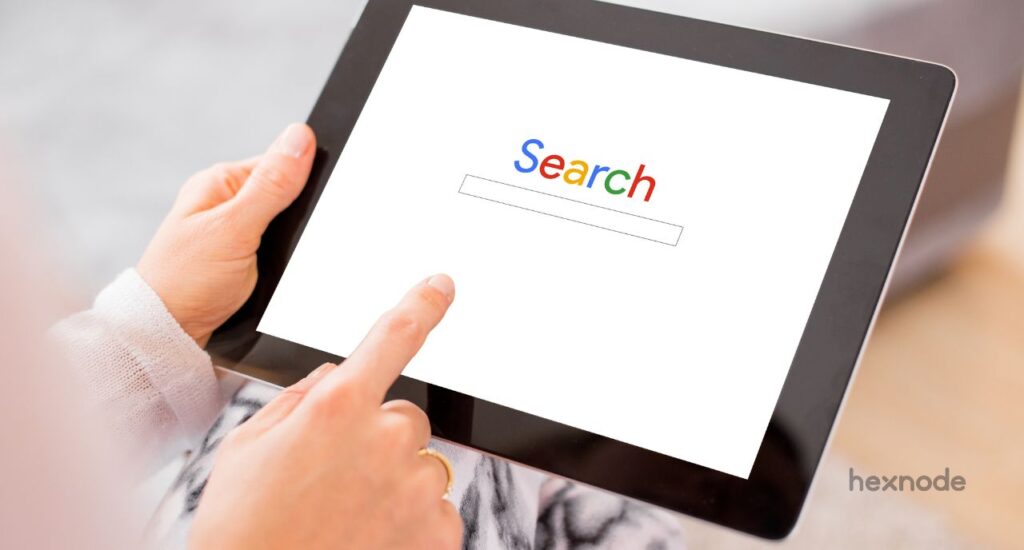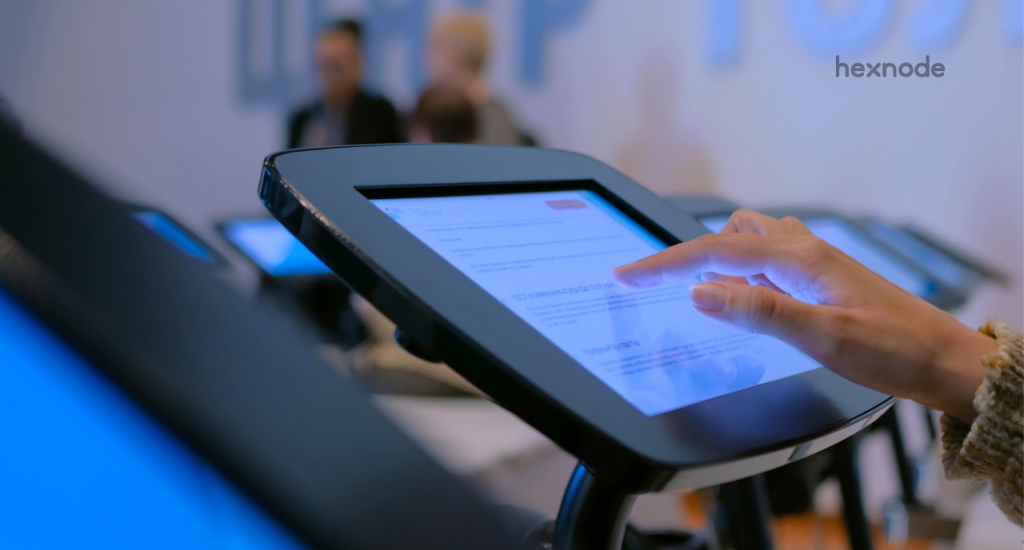Devices used for assessments must have the ability to lock itself to the assessment app. It must be able to refrain the test takers from switching between apps, invalidating test results, accessing features such as Spell-check, Dictionary Lookup, Auto-Correct, Smart Punctuation and so on. The necessary requirements can be met with the help of methods such as,
- Single App Mode
- Autonomous Single App Mode
- Guided Access Mode
- Assessment mode (Automatic Assessment Configuration)
Take a quick look at the table to understand the requirements for each of the methods.
| Features | Single App Mode | Autonomous Single App Mode | Guided Access Mode | Assessment mode (Automatic Assessment Configuration) |
|---|---|---|---|---|
| Do devices require an MDM to be installed in it? | Yes | Yes | No | No |
| Do devices require Supervision? | Yes | Yes | No | No |
| Is app support necessary for the implementation? | No | Yes | No | Yes |
| Do devices require additional restrictions during setup? | Yes | Yes | Yes | No |
| How to Exit from the mode? | Requires an MDM/Apple Configurator2 | Requires an MDM/Apple Configurator2 | Enter the exit passcode/Drain device battery completely and reboot after connecting to power. | App releases itself after the user signs out/Drain device battery completely and reboot after connecting to power |
| Typical Scenario | Customer interaction with kiosk | Patients check in with the doctor | Focus a child’s attention to a single app. | Students taking summative tests |
These methods are quite simple, yet it can be challenging to narrow them down to your requirements. This is a quick guide to learn and evaluate Single App Mode vs Autonomous Single App Mode vs Guided Access Mode vs Automatic Assessment Configuration. Here is a brief description of each of the assessment methods.
- Single App Mode (iOS 7.1 and above)
- Requirements:
- Using SAM via Apple Configurator or MDM
- Autonomous Single App Mode (iOS 7.1 and above)
- Requirements:
- How to enable Autonomous Single App Mode using Hexnode MDM?
- Guided Access Mode (iOS 7.1 and above)
- How to set up a Guided Access Mode?
- How to start a Guided Access Mode?
- How to end a Guided Access Mode?
- Limitations of Guided access mode
- Assessment mode (iOS 9.3.2 or later)
- Requirements:
- Assessment restrictions with Assessment mode
Single App Mode (iOS 7.1 and above)
Single app mode (SAM) is a feature that locks devices to a single app and let users focus their devices to perform some specific task. The selected app automatically launches itself and runs in the foreground.
Requirements:
- iOS devices must be supervised.
- Devices must be enrolled in an MDM (Enroll with Hexnode MDM).
- Devices should be connected to a Wi-Fi network.
- The app you wish to launch must be installed in the devices.
Using SAM via Apple Configurator or MDM
Single App Mode can be enabled by either one of the following methods:
Apple Configurator:
Apple Configurator is an application developed by Apple Inc. that allows administrators of business and educational organizations to configure profiles and settings on iPads and iPhones by using a USB connection. It is not a scalable option. To enable and disable single app mode using configurator the devices have to be physically connected to the Mac which is a mundane and time-consuming process. This makes it a poor choice for devices in different locations.
How to enable Single app mode using Apple Configurator 2?
You can connect your device to a Mac, use Apple Configurator to place your iOS/iPadOS device in supervised mode, and follow the below steps to enable the single app mode.
- Open the Apple Configurator app and select the device.
- Go to Actions > Advanced > Start Single App Mode.
- Select the required app from the list of apps installed on the device.
- Click the Options button and choose which features are to be enabled in Single app mode.
Under “Always Enabled”, enable/disable the following features:- Touch
- Motion (Screen Rotation)
- Volume Buttons
- Side Switch
- Sleep/Wake button
- Auto-Lock
- VoiceOver
- Zoom
- Invert Colors
- AssistiveTouch
- Speak Selection
- Mono Audio
Under “Accessibility Shortcut”, allow/disallow the following options:
- VoiceOver
- Zoom
- Invert Colors
- AssistiveTouch
MDM:
MDM Software allows administrators to enable Single app mode over the air across multiple devices simultaneously. Administrators can enable single app mode remotely at the beginning of the assessment and disable it after the assessment has completed.
You can enforce restrictions by enabling/disabling features including,
- Sleep/Wake button
- Volume Button
- Assistive Touch
- Voice Over
- Speak Selection
- Zoom
- Touch
- Mono Audio
- Auto Lock
- Screen rotation
- Ringer switch
- Invert colors
You can also choose what can be done when the user triple clicks the home button by enabling/disabling the User Enabled options including,
- VoiceOver
- Zoom
- Invert colors
- AssistiveTouch
Suppose that the iPad battery drains completely and the device shuts down. When rebooted, a device that ran in single app mode will re-launch the app and continue running in the same mode.
How to enable Single App Mode (Kiosk) in Hexnode MDM?
- Log in to your Hexnode MDM Console.
- Navigate to Policies and click on New Policy. Choose New Blank Policy and click on Select.
- Name the new policy and give a brief description for the same (Optional).
- Go to iOS Kiosk Lockdown under Kiosk lockdown (for Supervised iOS Devices only) ,Select Single App Kiosk and click on Configure.
- Click on + icon and select the app from the list. Hexnode MDM allows you to enforce additional restrictions (for iOS 7+) from Advanced Kiosk Settings.
- Click on Policy Targets > +Add Devices. Add all the devices you wish to associate the new kiosk policy to and click OK. Click on Save.
OR
- Perform steps 1-5 and click on Save.
- Navigate to Policies. Select your new kiosk policy.
- Click on Manage > Associate Targets.
- Select either one of the options mentioned below to associate the policy to.
- Device
- User
- Device Group
- User Group
- Domain
- Click on Associate.
Once you have completed the steps, your device(s) will enter the single app mode.
How to disable Single App Mode (Kiosk)?
You can disable kiosk in 2 ways:
- Using an MDM
- Using Apple Configurator
Disable single app mode (kiosk) using Hexnode MDM
Let’s take a look at how Hexnode MDM makes this work easy for you. Hexnode MDM supports several methods to exit from a kiosk.
- Log in to your Hexnode MDM Console.
- Click on Manage > Devices.
- Select the device you wish to dissociate the policy and go to the device summary page.
- Click on Policies. Delete your kiosk policy from the list by clicking on the trash icon.
OR
- Log in to your Hexnode MDM Console.
- Click on Policies. Select your kiosk policy.
- Click on Manage > Move to Archive.
- Go to Archived Policies > Select the kiosk policy and click on the trash icon to delete the policy permanently.
OR
- Log in to your Hexnode MDM Console.
- Go to Policies. Click on the kiosk policy or click on the Edit policy icon.
- Go to Policy Targets. Click on remove for disaccociating the kiosk policy with a particular device.
- Click on Save.
Disable using Apple Configurator
This method is ideal if your device isn’t connected to any networks.
- Connect your device with Mac that has Apple Configurator installed in it.
- Open Apple Configurator where you will see your iOS device.
- Right Click on the device, select Remove option and click on Profiles.
- Choose the profile ‘Hexnode MDM’ and click Remove Profiles.
- When the confirmation box pops up, click on Remove.
Autonomous Single App Mode (iOS 7.1 and above)
Autonomous Single App mode allows an app to lock itself into Single App Mode and release itself from this mode. The device will be locked down to the app when the user signs into the app and released only when the user signs out of the app. No other features are available for user access. Since the session is started and stopped locally on the device, it does not necessarily require an internet connection. The developed iOS apps must be coded to make the API calls in order to support Autonomous Single App Mode.
Requirements:
- iOS devices must be supervised.
- Devices must be enrolled in an MDM (Enroll in Hexnode MDM)
- The app must be whitelisted with MDM.
How to enable Autonomous Single App Mode using Hexnode MDM?
- Log into your Hexnode MDM Console.
- Navigate to Policies > New Policy. Choose New Blank Policy and Click on Select.
- Name the new policy and give a brief description for the same (Optional).
- Go to iOS Kiosk Lockdown under Kiosk Lockdown (for Supervised iOS devices only), select Autonomous Single App Mode and click on Configure.
- Click on + icon and select the app from the list.
- Click on Policy Targets > +Add Devices. Add all the devices you wish to associate the new kiosk policy to and click OK.
- Click on Save.
OR
- Perform steps 1-5 and click on Save.
- Navigate to Policies. Select your new kiosk policy.
- Click on Manage > Associate Targets.
- Select either one of the options mentioned below to associate the policy to.
- Device
- User
- Device Group
- User Group
- Domain
- Click on Associate.
Once you have completed the steps, your device(s) will enter the Autonomous Single App Mode.
Guided Access Mode (iOS 7.1 and above)
Guided Access Mode is an accessibility feature that allows a user to manually limit a device to a single app. It restricts users from switching between apps, accidentally exiting the app, or returning to the home screens. You can hand over your device without having to worry about another user prying on your personal information. This accessibility feature proves to be useful in different realms such as education, businesses, research, restaurants, etc.
How to set up a Guided Access Mode?
- Launch the settings app on your device.
- Tap on General > Accessibility > Learning > Guided Access
- Turn on Guided Access by toggling the slider.
- Tap on Passcode Settings > Tap on Set Guided Access Passcode to set a passcode to exit the session.
- Enter and confirm the passcode
- Choose to set up Face ID or Touch ID as a means to end the Guide access session.
- Switch Accessibility Shortcut ON.
How to start a Guided Access Mode?
- Launch the app you wish to use.
- Tap the home button 3 times for iPhone 8 or later. Triple-tap the side button if it’s iPhone X or later. This will open a Guided Access Menu.
- Click on areas on the screen that you would like to make inaccessible.
- Tap on the options button in bottom left corner to permit access to various features like Sleep/Wake button, Volume Buttons, Motion, Keyboards, Touch, Dictionary Lookup, and Time limit.
- Click on start to begin the guided access session.
Or simply,
- Launch the app you wish to use.
- Ask Siri to “Turn ON Guided access”.
How to end a Guided Access Mode?
There are two methods to end your guided access session.
- Using Touch Id
- Using guided access passcode.
How to end a Guided Access Session using Touch Id?
Before you start a session,
- Go to Settings > General > Accessibility > Guided Access.
- Click on Passcode Settings >Turn on Touch Id.
To end a session, Tap the Home button once and then use your touch id.
How to end a Guided Access Session using Guided Access Passcode?
Click on the home button thrice and then enter the Guided Access Passcode.
If the user tries to exit the session, a message is displayed to the user informing him to tap the home button three times to exit. If you forget your guided access passcode, wait for the device battery to drain completely. Once you reboot the device after connecting to power, you’ll be redirected to your home screen.
Limitations of Guided access mode
Guided Access requires each device to be configured manually. Also, it does not provide support for restrictions such as Spell-Check, Auto-Correction, Dictionary-Lookup etc. Hence, it is not recommended for summative assessments. Another major drawback is that it can be easily tweaked by triple-tapping the home/side button and guessing the guided access PIN.
Assessment mode (iOS 9.3.2 or later)
Assessment mode (formerly known as Automatic Assessment Configuration (AAC)) enables apps to automatically lock and configure iPads for assessments. It allows assessment developers to build apps that will lock an iPad to single app and invoke restrictions once the user logs in. The feature is also supported on macOS Catalina 10.15.4 or later.
Suppose that you wish to give students a test. You have to restrict students from changing device settings, switching between apps and from using built-in features like Dictionary Definition Lookup, Auto Correct, Spell Checker, Sharing, Predictive Keyboard etc. This requires the iPad to be locked down to a single assessment app.
Assessment mode (Automatic Assessment Configuration) is one of the favored methods for executing assessments on iPad as it does not require any manual interference in configuration or management.
Requirements:
- Managed or unmanaged devices.
- No need to whitelist apps.
Assessment restrictions with Assessment mode
The assessment restrictions enforced by Assessment mode in iOS include
- Auto correct and spell checker
- Universal Clipboard (iOS 10.2 and later)
- Remote observation with Classroom (iOS 10.3.2 and later)
- Predictive keyboard
- Sharing
- Keyboard shortcuts
- Screen Recording (iOS 11 and later)
- Dictation (iOS 10.3 and later)
- Speak selected text (iOS 11 and later)
- Dictionary definition lookup
- Auto-Capitalization, Character Preview and Smart Punctuation (iOS 11 and later)
- Siri
For further protection, you can separately disable other features including Voice Control, VoiceOver, and emoji keyboard which are not automatically disabled by the Assessment mode.
It is advised to ensure that your assessment app provides support for Assessment mode (Automatic Assessment Configuration) by checking with the assessment provider.
You can also configure your iPad for assessment using any of the methods mentioned below:
- Mobile Device Management(MDM)
- Supervision
- Configuration profiles
A Configuration profile is an xml file that enables users to set restrictions for devices. With configuration profiles, administrators can enable additional assessment restrictions including grammar check, shared text, etc. A configuration profile contains settings for wi-fi, Web Clip, email, LDAP, VPN. If you have a large number of devices to deploy, creating a configuration profile would be an ideal option for high stakes assessment activities.





